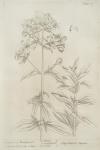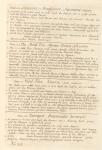

 113. Sopewort or Brusewort. Saponaria vulgaris.
113. Sopewort or Brusewort. Saponaria vulgaris.
1. It grows to be a foot and a half high, the Leaves are a grass Green, and the Flowers a pale Purple.
2. It grows in Watery Places near Rives and flowers for several Months in the Summer.
3. It is called Saponaria, or Sopewort, because its Juice will get greasy Spots out of Cloaths.
It is esteemed opening and attenuating and somewhat sudorific. It is recommended by some against the Lues Venerea.
Outwardly applied it helps hard Tumours and Whitlows.
4. Greek, Λυχνίς. Latin, Saponaria vulgaris or Lychnis Saponaria dicta. Spanish, . Italian, Lichnide coronaria. French, . German, Margenroslin. Dutch, Seepkruyd.
Henriette's comment. The names point to Lychnis coronaria, the image is of Saponaria officinalis.

 114. The Mirtle Tree. Myrtus. - Baetica sylvestris.
114. The Mirtle Tree. Myrtus. - Baetica sylvestris.
1. This is a little Tree shooting forth many slender tough Branches, the Leaves of which are a grass Green, and the Flowers White.
2. It grows wild in Spain and Italy, flowring in August.
3. The Leaves as well as the Berries are accounted drying & binding, good for a Diarrhoea or Dysentery, spitting of Blood, catarrhous Defluxions upon the Breast, the Fluor albus, the falling down of the Womb or Fundament, both taken inwardly.
Outwardly they are used in Powders & Injections. Preparations from ye Berries are Syrupus Myrtinus. Pul. Diamargariton fritid. Ol. Myrtinum. Ung. adstringens. Fernel. Empl. ad Rupturas.
4. Greek, μυρσίνη. Latin, Myrtus. Spanish, Murta, or Rajam. Italian, Myrto mortina & Mortella. French, Meurte. German, Belsckheiderbeerbaum. Dutch, Myrte Boom.

 115. Toad-Flax. Linaria. - lutea vulgaris.
115. Toad-Flax. Linaria. - lutea vulgaris.
1. The Stalks grow a little more than a foot high, the Leaves are a willow Green, and the Flowers Yellow.
2. It grows common on Banks and Hedges, and flowers in Iuly.
3. The whole Plant is used, being accounted diuretic, opening Obstructions of the Liver & Spleen, helping the Dropsy and Jaundice, which it carries off by Urine. The Ointment made with Hog's Lard, and a good Quantity of this Herb, is esteemed a good Remedy of the Piles by anointing the Part; at the time of Using it mix some of ye Yolk of an Egg with it.
The Officinal Preparation is ye Ung. Linariae.
4. Greek, οσυρίς. Latin, Linaria lutea vulgaris and Osyris. Spanish, Linaria. Italian, Linaria. French, Linaire. German, Harncraut. Dutch, .

 116. Tarragon. Dracunculus hortensis.
116. Tarragon. Dracunculus hortensis.
Also see #017, Wormwood - #116, Tarragon
1. It grows to be two foot high, the Leaves are a shineing dark Green, and the Flowers a Yellowish colour.
2. It is planted in Gardens, and flowers in Iuly and August.
3. The Leaves which are chiefly used are accounted heating and drying, good for those who have cold Stomachs, for which they are often put into Sallads; Some say they expell Wind, provoke Urine & the Menses.
4. Greek, . Latin, Dracunculus hortensis. Spanish, Dragono. Italian, Dragone. French, Targon. German, Draguncell. Dutch, Dragon.

